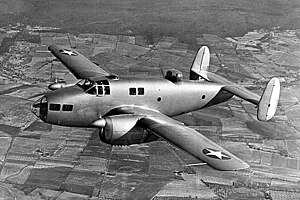Fairchild AT-21 Gunner
| AT-21 Gunner | |
|---|---|
 |
|
| AT-21 | |
| Role | Trainer |
| Manufacturer | Fairchild |
| First flight | 1943 |
| Introduction | 1943 |
| Retired | 1944 |
| Primary user | United States Army Air Forces |
| Number built | 175 |
| Variants | Fairchild BQ-3 |
The Fairchild AT-21 was an American World War II specialized bomber crew trainer, intended to train crews in the use of power gun turrets or a gun on a flexible mount, as well as learn to function as a member of a crew. It had a brief career as a training aircraft before modified bombers took over this role.
The United States Army Air Forces (USAAF) laid out a specification for a specialized bomber trainer, ordering two prototypes from Fairchild Aircraft. The XAT-13 powered by two 450 hp (336 kW) Pratt & Whitney R-1340-AN-1 radial engines, emerged as a "scaled down" bomber with a single machine gun in the glazed nose and a top turret with twin machine guns and fitted with tricycle landing gear. The concept was to have a single type that was able to duplicate the bomber crew positions from piloting, navigation, bomb aiming/dropping to aerial gunnery.
The second prototype, designated the XAT-14 was similar in layout but was powered by two 520 hp (388 kW) Ranger V-770 inline inverted 12-cylinder vee-type engines. A further refinement to suit the aircraft for bombardier training with the nose gun and turret removed, led to a new designation, the XAT-14A. Both prototypes featured an unusual construction, being built from "Duramold" plastic-bonded plywood. At the end of the testing period, the USAAC ordered the inline version as the AT-21 Gunner, specialized for gunnery training. The AT-21 had a crew of five, pilot, co-pilot/gunnery instructor and three pupils.
Fairchild Aircraft Company built one aircraft in Hagerstown and 106 aircraft at their Burlington, North Carolina plant in 1943 and 1944, while Bellanca Aircraft built 39 at New Castle, Delaware, and McDonnell built 30 aircraft at their St. Louis plant. Both companies were enlisted to speed production and delivery to training units.
The AT-21 proved to be unsuitable for use as a trainer due to vibration and oscillation tendencies as well as an inherent instability caused by the short distance between the rudders and the gull wing resulting in unacceptable yaw even when slight rudder movements were made.
...
Wikipedia
